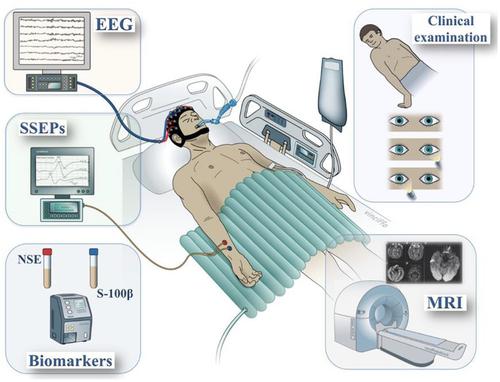当前位置:
X-MOL 学术
›
Ann. N. Y. Acad. Sci.
›
论文详情
Our official English website, www.x-mol.net, welcomes your
feedback! (Note: you will need to create a separate account there.)
Outcome and prognostication after cardiac arrest
Annals of the New York Academy of Sciences ( IF 4.1 ) Pub Date : 2021-09-27 , DOI: 10.1111/nyas.14699 Theresa Henson 1 , Cameron Rawanduzy 2 , Marco Salazar 2 , Adonai Sebastian 2 , Harli Weber 2 , Fawaz Al-Mufti 1, 2 , Stephan A Mayer 1, 2
Annals of the New York Academy of Sciences ( IF 4.1 ) Pub Date : 2021-09-27 , DOI: 10.1111/nyas.14699 Theresa Henson 1 , Cameron Rawanduzy 2 , Marco Salazar 2 , Adonai Sebastian 2 , Harli Weber 2 , Fawaz Al-Mufti 1, 2 , Stephan A Mayer 1, 2
Affiliation

|
The outcome after out-of-hospital cardiac arrest has historically been grim at best. The current overall survival rate of patients admitted to a hospital is approximately 10%, making cardiac arrest one of the leading causes of death in the United States. The situation is improving with the incorporation of therapeutic temperature modulation, aggressive prevention of secondary brain injury, and improved access to advanced cardiovascular support, all of which have decreased mortality and allowed for better outcomes. Mortality after cardiac arrest is often the direct result of active withdrawal of life-sustaining therapy based on the perception that neurological recovery is not possible. This reality highlights the importance of providing accurate estimates of neurological prognosis to decision makers when discussing goals of care. The current standard of care for assessing neurological status in patients with hypoxic-ischemic encephalopathy emphasizes a multimodal approach that includes five elements: (1) neurological examination off sedation, (2) continuous electroencephalography, (3) serum neuron-specific enolase levels, (4) magnetic resonance brain imaging, and (5) somatosensory-evoked potential testing. Sophisticated decision support systems that can integrate these clinical, imaging, and biomarker and neurophysiologic data and translate it into meaningful projections of neurological outcome are urgently needed.
中文翻译:

心脏骤停后的结果和预后
历史上,院外心脏骤停后的结果充其量是严峻的。目前入院患者的总生存率约为 10%,这使得心脏骤停成为美国主要的死亡原因之一。随着治疗性温度调节、积极预防继发性脑损伤以及改善获得先进心血管支持的机会,情况正在改善,所有这些都降低了死亡率并带来了更好的结果。心脏骤停后的死亡率通常是由于认为神经功能无法恢复而主动停止维持生命治疗的直接结果。这一现实凸显了在讨论护理目标时向决策者提供准确估计神经系统预后的重要性。目前评估缺氧缺血性脑病患者神经状态的护理标准强调多模式方法,包括五个要素:(1)镇静后的神经系统检查,(2)连续脑电图,(3)血清神经元特异性烯醇化酶水平,( 4)磁共振脑成像,和(5)体感诱发电位测试。迫切需要能够整合这些临床、成像、生物标志物和神经生理学数据并将其转化为有意义的神经学结果预测的复杂决策支持系统。(3) 血清神经元特异性烯醇化酶水平,(4) 磁共振脑成像,和 (5) 体感诱发电位测试。迫切需要能够整合这些临床、成像、生物标志物和神经生理学数据并将其转化为有意义的神经学结果预测的复杂决策支持系统。(3) 血清神经元特异性烯醇化酶水平,(4) 磁共振脑成像,和 (5) 体感诱发电位测试。迫切需要能够整合这些临床、成像、生物标志物和神经生理学数据并将其转化为有意义的神经学结果预测的复杂决策支持系统。
更新日期:2021-09-27
中文翻译:

心脏骤停后的结果和预后
历史上,院外心脏骤停后的结果充其量是严峻的。目前入院患者的总生存率约为 10%,这使得心脏骤停成为美国主要的死亡原因之一。随着治疗性温度调节、积极预防继发性脑损伤以及改善获得先进心血管支持的机会,情况正在改善,所有这些都降低了死亡率并带来了更好的结果。心脏骤停后的死亡率通常是由于认为神经功能无法恢复而主动停止维持生命治疗的直接结果。这一现实凸显了在讨论护理目标时向决策者提供准确估计神经系统预后的重要性。目前评估缺氧缺血性脑病患者神经状态的护理标准强调多模式方法,包括五个要素:(1)镇静后的神经系统检查,(2)连续脑电图,(3)血清神经元特异性烯醇化酶水平,( 4)磁共振脑成像,和(5)体感诱发电位测试。迫切需要能够整合这些临床、成像、生物标志物和神经生理学数据并将其转化为有意义的神经学结果预测的复杂决策支持系统。(3) 血清神经元特异性烯醇化酶水平,(4) 磁共振脑成像,和 (5) 体感诱发电位测试。迫切需要能够整合这些临床、成像、生物标志物和神经生理学数据并将其转化为有意义的神经学结果预测的复杂决策支持系统。(3) 血清神经元特异性烯醇化酶水平,(4) 磁共振脑成像,和 (5) 体感诱发电位测试。迫切需要能够整合这些临床、成像、生物标志物和神经生理学数据并将其转化为有意义的神经学结果预测的复杂决策支持系统。











































 京公网安备 11010802027423号
京公网安备 11010802027423号